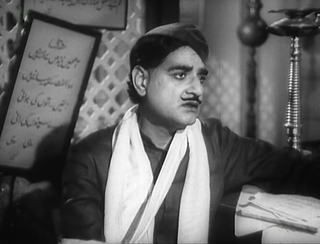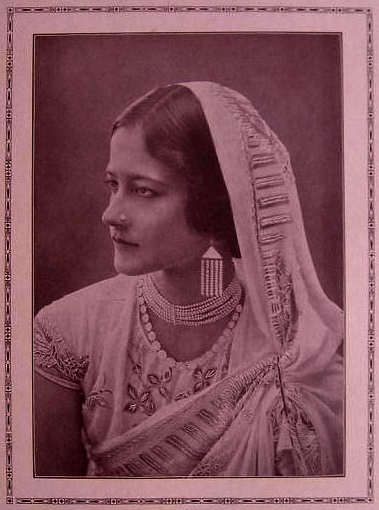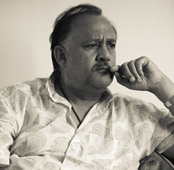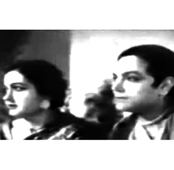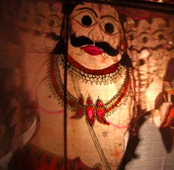-
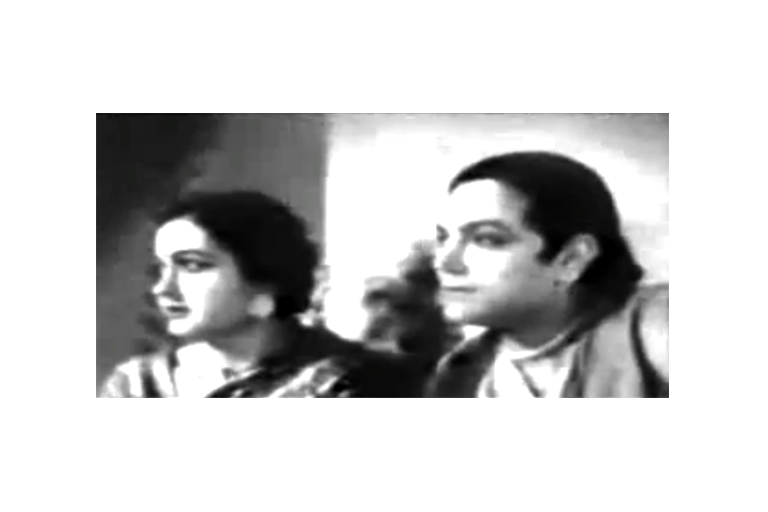 A screenshot of Najmul Hasan from Nartaki
A screenshot of Najmul Hasan from Nartaki
The past is not a foreign country but it is certainly largely undiscovered. In TBIP’s History Corner we bring to you stories, characters and anecdotes from times that must not be allowed to go away merely because they have gone by.
One of the most famous incidents in Hindi film history is the story of how Ashok Kumar became a star. How his name was actually Kumudlal Kunjilal Ganguly and how he was a mere lab technician for Bombay Talkies when Devika Rani Choudheri, the talented ‘first lady of Indian cinema’, eloped with an actor called Najmul Hasan, deserting both the film in which they had been cast as leads as well Himanshu Rai, Devika Rani’s husband and Hasan’s employer, and the founder and head of Bombay Talkies, India’s legendary film studio. Also, how Sashadhar Mukherjee, Ganguly’s brother in law who worked at Bombay Talkies then (he was later to become a renowned filmmaker in his own right), convinced Devika Rani to return, sans Hasan, and suggested Ganguly as a replacement for the male lead. And how Ganguly was chosen and re-christened, and how the film, Jeevan Naiya, was released in 1936.
A lot has been known and written about Ashok Kumar since then. As about Devika Rani, the brilliant co-founder of Bombay Talkies who ran the studio after Rai passed away. But there is one person involved in this incident whom we don’t really know anything about— Najmul Hasan, the actor Devika Rani had eloped with to set this sequence of events into motion in the first place. The actor who, in writer Saadat Hasan Manto’s words, “had decided to pull away the leading lady from the celluloid world to the real one”.
***
To begin with, the spelling of his name remains a mystery. It has been written as ‘Najmul Hasan’, ‘Najam-Ul-Hasan’ and ‘Najmul Hussain’ in different accounts. Bhaichand Patel says in his book Top 20: Superstars of Indian Cinema that Hasan, a tall handsome man, was “descended from Lucknow nobility” and that he had “signed for a string of films” with Bombay Talkies. According to Pakistani journalist Munir Ahmed Munir, who interviewed him shortly before he passed away, Hasan was studying law, but did not finish his studies as he moved to Bombay. There is no record of whether he did this to join the movie business, but in the city he met Himanshu Rai who persuaded him to star in Jawani Ki Hawa, Bombay Talkies’ first, Hasan’s too.
Directed by Franz Osten, the movie is a whodunit about a woman (Kamala, played by Devika Rani) who elopes with her childhood friend and lover (Ratanlal, played by Hasan) on the day of her marriage. The couple escapes the city on a train. While on board, her father catches up with her and demands that she marry the man he had sought for her. A murder follows. The film’s plotline bears many similarities to the Agatha Christie mystery Murder on the Orient Express which had just been published, in 1934.
In a prototypical case of life imitating art, Hasan and Devika Rani, who had fallen for each other’s charms during Jawani Ki Hawa, eloped to Calcutta by train during the shooting of their next, Jeevan Naiya (1936). Writes Patel:
“To the world, Bombay Talkies- with its great scripts, talented actors, and high technical quality, seemed one of the most successful studios in India. This image of success, however, covered the personal costs of running such an intensive film factory; strains and cracks were beginning to take place within. Rai had become a workaholic, desperately trying to balance finances and productions, some of which flopped in the market. There was also gossip that his young wife Devika was having affairs. True or false, Niranjan Pal alleged that Devika had become close to her co-star while shooting the film Jawani Ki Hawa.”
Sashadhar Mukherjee and Himanshu Rai eventually tracked the couple down to Calcutta’s Grand Hotel and Mukherjee convinced Devika Rani to return. Hasan stayed on in Calcutta. Manto writes: “He was left to join the ranks of those who are fated to be deserted by their beloveds for less emotional, but weightier political, religious or simply material considerations. As for the scenes he had already done, they were trashed.”
In Calcutta Hasan joined New Theatres which had made a name for itself by launching singer-actors and crafting musical hits in the 1930s. It had among its ranks legends such as K. L. Saigal, Kanan Devi, and Pankaj Mullick. The growing prominence of multi-talented performers, not just in New Theatres, but also in other renowned production houses of the time like Pune’s Prabhat Studios and Calcutta’s Madan Theatres meant that Hasan would have a tough time making his presence felt.
Playing second lead to co-stars like the majestic Prithviraj Kapoor in the reformist drama Anath Ashram (1937) or to K.L. Saigal in Dushman (1938) didn’t help. His performances weren’t particularly lauded or praised. Yet he was a part of two of the bigger musicals of his era: Kapal Kundala (1939) and Nartaki (1940). Kapal Kundala didn’t do well. Nartaki, a costume drama set sometime in the 16th century, was one of the highest grossing films of the year, but it didn’t to do much for his career either.
It is during his time in Calcutta that Hasan is rumoured to have had a roaring affair with another leading lady of the 1930s— singer and theatre actor Jahan Ara Kajjan, known at the time as the ‘Lark of India’.
Born in Patna, Jahan Ara was a Madan Theatres employee. Information on her life, and the chronological order of her filmography, is hard to find but Shirin Farhad and Laila Majnu (both 1931) seem to have been among her early prominent films. A veteran of the Urdu and Parsi theatre circuits, she made for a formidable team with another singing star of the period— Master Nissar.
Shirin Farhad, which was released just two months after the path breaking Alam Ara, was twice as successful as the latter, with 17 songs sung by Jahan Ara and Master Nissar themselves. Jahan Ara was also a part of Bilwamangal (1932), the first ever Hindi film which was shot in colour and sent abroad for printing. Her Indrasabha (1932), the operatic-themed rendition of the Urdu play Inder Sabha, originally written by dramatist Agha Hasan Amanat, was a stupendous hit with a record 70 songs.
Described by film historian B. D. Garga as an actress whose “spectacular beauty was her wealth”, there are accounts of Jahan Ara having been a poetess and owning two tiger cubs. Also that, along with actress Mahjabeen, she was a regular at the city’s coveted Calcutta Club.
Jahan Ara passed away in 1945 at the young age of 30. Her last film to have been released while she was alive was Bharthari (1944). Two other films she did—Jadui Putli (1946) and Tiger Man (1947)—were released after her death.
Najmul Hasan’s last film in pre-Partition India was the Hindi version of the 1942 bilingual Meenakshi. He acted in a handful of films after migrating to Pakistan, one of which—Heer Ranjha (1970), a Punjabi film—was a huge hit. But even here Hasan had only a supporting role (he played Heer’s father). Other films during this period were Aashiana (1964), Doctor (1965), and Mirza Jatt (1967).
He died in Lahore in 1980. Film historians are sketchy about further details on his life. Raju Bharatan, when asked about the actor’s time in Pakistan remains noncommittal with a “he was nothing great there either”. S. M. M. Ausaja, when asked about Hasan, says, “Why him? He was a bad actor and isn’t worth writing about.”
Yet he was one of eight yesteryear stars interviewed by Pakistani journalist and writer Munir Ahmed Munir for his book Out Of Date. “It is regrettable that our movie industry has failed to establish a fund for those who were once great and famous,” Munir quotes Hasan as having said to him. “Men like Sadiq Ali, one of the renowned heroes of his time, who spent his last years begging.”
The Man who Missed the Train
SpecialOctober 2013
 By Roshni Nair
By Roshni Nair
Roshni Nair is Trainee Correspondent at The Big Indian Picture




